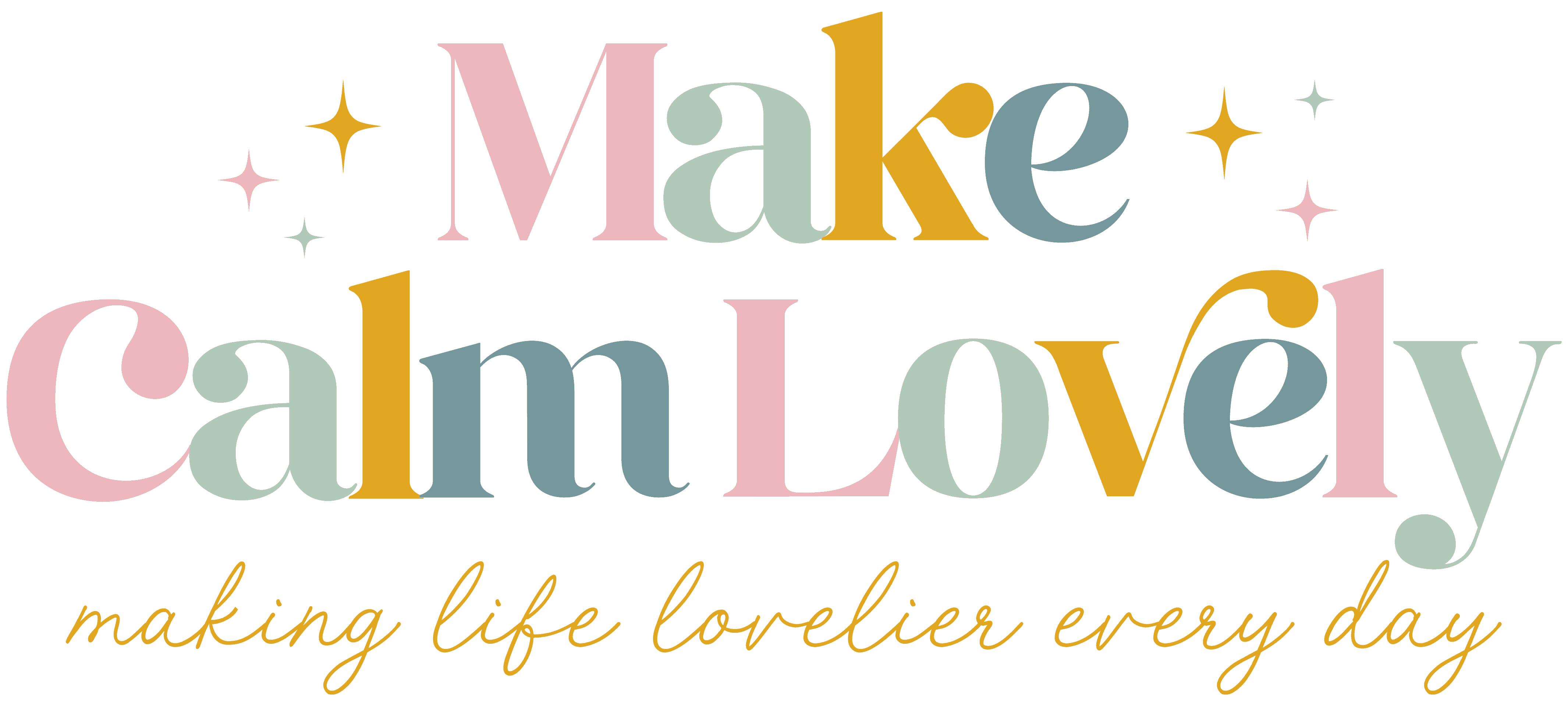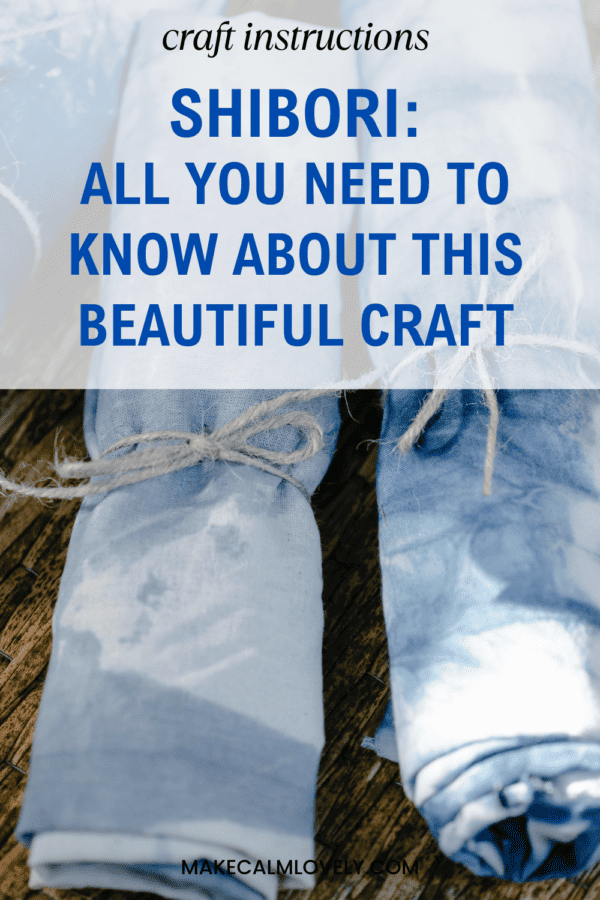Shibori – all you Need to Know about the Beautiful Japanese Dyeing Craft
Shibori is a Japanese dyeing technique that produces beautiful and vivid blue and white patterned fabrics. Here is all you need to know about the art of Shibori
You have probably seen the beautiful blue and white tie-dye creations on fabrics, including cushions, shawls and more.
That beautiful blue and white pattern has been around for centuries and is created with a dyeing technique known as Shibori.
Shibori orginated in Japan, where it has been practiced for centuries.
Every piece of fabric dyed using the Shibori technique is unique and different. This makes it a wonderful craft to do, as each piece you create will be different to the one before and the next!
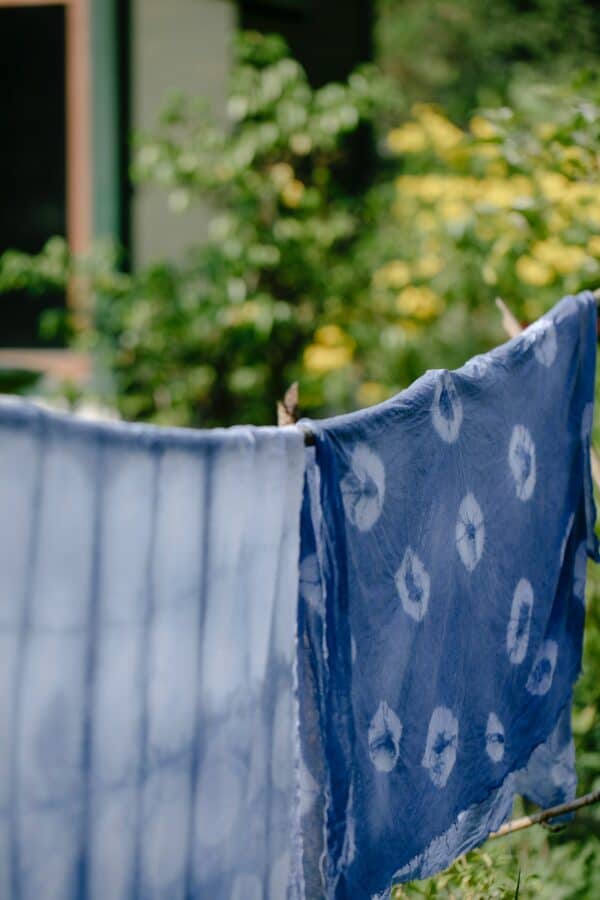
This post contains affiliate links. This means that if you click on a link in this post and make a purchase via that link I may receive a small commission, at absolutely no additional cost to you.
What is Shibori?
Shibori is a traditional Japanese resist dyeing technique that involves manipulating fabric to create intricate patterns by folding, binding, stitching, twisting, or compressing it before dyeing.
The term for this dyeing technique – Shibori – comes from the Japanese word Shiboru – which means to wring or squeeze.
The origins of Shibori are in Japan, where for centuries this unique dyeing technique has been used to produce beautiful decorative fabrics that are used clothing and other products.
Shibori is compared a lot to the modern tie-dye technique, but it is actually far more intricate than that. Shibori ties together smaller pieces to create more detailed and elaborate patterns.
Different Methods of Shibori Dyeing
There are various methods of Shibori, each producing distinct patterns and designs. Here are some of the most common Shibori methods:
- Kanoko Shibori (Bind and Dye Technique): Also known as “tie-dye,” this method involves binding sections of fabric with thread, string, or rubber bands to create resist areas. The bound fabric is then dyed, and the areas under the bindings remain undyed, resulting in intricate patterns of dots or clusters.
- Kumo Shibori (Spiderweb or Pleat and Bind Technique): In this technique, fabric is folded, pleated, or gathered and then bound with thread in a radial pattern, resembling a spider’s web. The fabric is dyed, and the areas under the binding remain undyed, creating a distinctive spiderweb-like pattern.
- Arashi Shibori (Pole-Wrapping Technique): The fabric is wrapped diagonally around a pole or tube and then compressed tightly. The wrapped fabric is then dyed, and the result is a pattern of diagonal lines that resemble rain falling at an angle (arashi means “storm” in Japanese).
- Nui Shibori (Stitched or Sewn Technique): This technique involves stitching through layers of folded fabric using a needle and thread. The stitching creates gathers or pleats, and when the fabric is dyed and the threads are removed, it reveals intricate and often linear patterns.
- Itajime Shibori (Shape-Resist Technique): Fabric is folded accordion-style and then sandwiched between two flat objects, such as wooden blocks or acrylic sheets. The fabric is then bound with string or clamps to hold the layers tightly in place. After dyeing, the areas covered by the objects remain undyed, resulting in geometric and symmetrical patterns.
- Bōshi Shibori (Capped Technique): This method involves capping sections of fabric with tight stitching before dyeing. The stitches create areas that resist the dye, producing circular or semicircular patterns.
- Mokume Shibori (Wood Grain Technique): In this technique, the fabric is accordion-folded and then sandwiched between two wooden blocks. The blocks are then tightly bound with string, and after dyeing, the resulting pattern resembles wood grain.
- Tesuji Shibori (Hand Pleated Technique): The fabric is carefully hand-pleated and then bound with string or thread before dyeing. The resulting patterns can range from simple stripes to intricate geometric designs.
- Suji Shibori (Line Technique): This technique involves binding parallel lines of fabric with thread before dyeing. The lines can be evenly spaced or varied, creating linear patterns.
- Hira-Nui Shibori (Running Stitch Technique): Similar to nui shibori, this technique involves stitching through the fabric. However, in hira-nui shibori, the stitches are evenly spaced and parallel, resulting in a more evenly textured pattern.
These are just a few examples of Shibori techniques, and there are many variations and combinations that artists and craftsmen have developed over time. Each method produces unique patterns and designs, and the choice of technique depends on the desired outcome and the artist’s creativity.
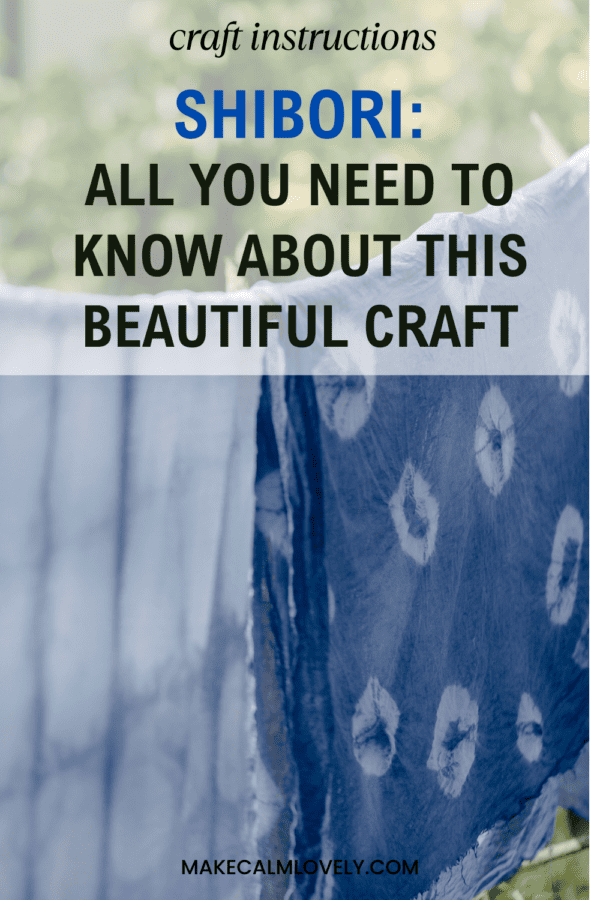
Take the FREE 30 Day Start a New Craft Challenge!
Why is Shibori Always Blue?
While Shibori is often associated with blue hues, it’s not always limited to blue colors. The association with blue is primarily due to the historical use of indigo dye, which produces shades of blue.
Indigo dye is a natural plant-based dye that has been used for centuries in various cultures, including Japan, to create deep blue colors. It has a unique quality that allows it to penetrate fabric fibers unevenly, resulting in the characteristic variations in color intensity and shading that are often seen in Shibori patterns.
The preference for blue in Shibori has cultural, historical, and artistic significance:
- Historical Use of Indigo: Indigo dye has a long history in Japan and other parts of the world. It was one of the most widely used natural dyes due to its availability and ability to produce a range of blue shades. Indigo dye was commonly used for clothing, including kimonos and other traditional garments.
- Symbolism: Blue is a color that holds symbolism in many cultures. In Japan, blue is associated with purity, calmness, and protection against evil spirits. These cultural associations likely contributed to the popularity of blue in traditional textiles.
- Artistic Tradition: Over time, the use of indigo dye and the creation of blue Shibori patterns became a recognized artistic tradition. Artists and craftsmen developed various Shibori techniques that allowed them to explore and express their creativity within the constraints of the dyeing process.
While blue is the most iconic color associated with Shibori, contemporary artists and dyers have expanded the use of Shibori techniques to incorporate a wide range of colors, using synthetic dyes in addition to natural indigo. This has led to a vibrant and diverse array of Shibori creations that go beyond the traditional blue palette.
In summary, while Shibori is often associated with blue due to historical and cultural reasons related to the use of indigo dye, it is not limited to this color. Modern practitioners of Shibori have embraced a broader color spectrum, allowing for a creative exploration of patterns and hues.
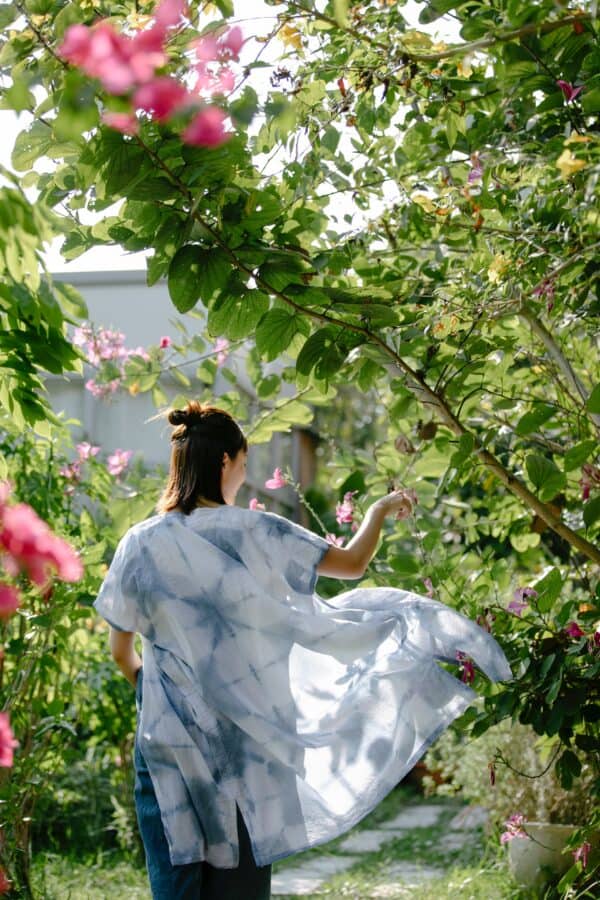
Related: DIY Linen Fabric Cocktail Napkins
Materials you Need for Shibori
These are the main materials that you need for Shibori. You don’t need a lot of materials, and this is also a craft that doesn’t cost a lot to do.
- Fabric (cotton, silk, or other natural fibers work best)
- Fabric dye (indigo is commonly used, but you can use other dyes as well)
- Rubber bands, strings, clamps, or other binding materials
- Plastic or rubber gloves
- Plastic buckets or containers for dyeing
- Plastic sheet or tarp to protect your work area
What is the Best Fabric to use for Shibori?
You can use many different fabrics for Shibori dyeing, and you can create your own unique pieces by experimenting with different fabrics too.
But the best fabrics to use for Shibori are cotton muslin, cotton, raw silk, habotai silk, or hemp.
Modern fabrics can be coated, and you should try to find non-coated more natural fabrics, as they will dye much better and be easier to work with.
What is the Best Dye to use for Shibori?
Traditionally Shibori was made with indigo dye, which used indigo flowers, which was mixed in with with root madder and other ingredients.
There are many different blue dyes that you can buy today. For the indigo color you will need to search for the right dye that gives you the results you want.
Indigo dyes available today include indigo crystals, and liquid dyes. There are also many different indigo dyeing kits that you can purchase.
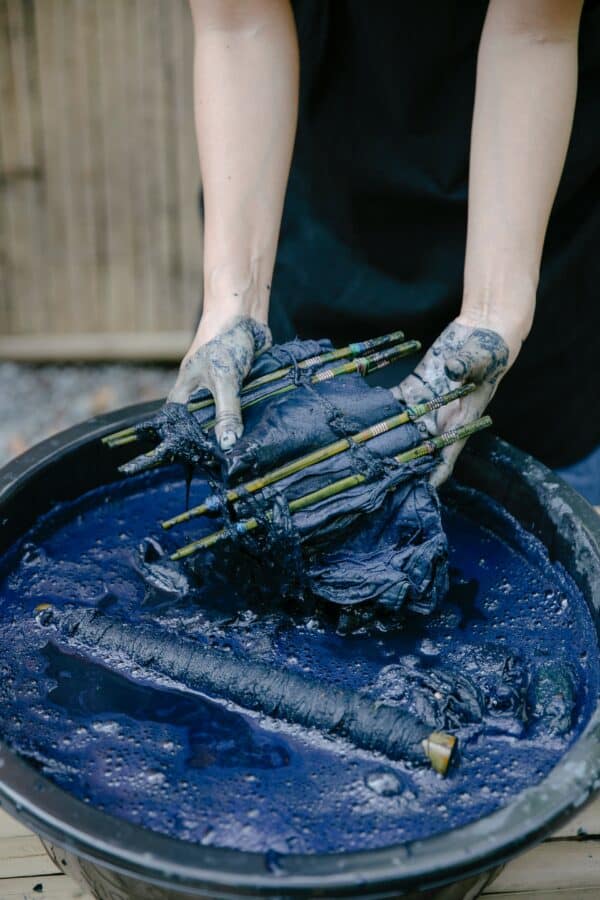
How to do Shibori Dyeing
There are several steps to Shibori dyeing:
- Prepare the Fabric:
- Wash and thoroughly rinse the fabric to remove any sizing or impurities that could affect the dyeing process.
- Cut or fold the fabric to the desired size and shape. Make sure it’s slightly larger than your intended finished size, as the fabric may shrink during the dyeing process.
- Choose a Shibori Technique:
- There are various Shibori techniques, such as Itajime (fold and clamp), Kumo (twist and bind), Arashi (pole wrapping), Nui (stitched), and more. Choose the technique you’d like to use based on the pattern you want to create.
- Manipulate the Fabric:
- Depending on the technique, fold, pleat, twist, bind, or stitch the fabric. This will create areas of resist that will prevent the dye from penetrating.
- Dyeing Process:
- Prepare the dye bath according to the manufacturer’s instructions.
- Wear gloves to protect your hands from dye.
- Submerge the manipulated fabric into the dye bath. Make sure to agitate and move the fabric to ensure even dye penetration.
- Rinsing and Unfolding:
- Carefully remove the fabric from the dye bath and rinse it under cold water to remove excess dye.
- Gently unfold or unbind the fabric to reveal the pattern. Be patient and careful during this step to avoid smudging the design.
- Fixing the Dye:
- Some dyes require heat setting or additional steps to fix the color. Follow the dye manufacturer’s instructions for this step.
- Final Rinse and Drying:
- Rinse the fabric under cold water until the water runs clear.
- Wash the fabric with a mild detergent to remove any remaining dye or chemicals.
- Allow the fabric to air dry or tumble dry, depending on the care instructions for the specific fabric you used.
Shibori is a hands-on and creative process, and experimentation is encouraged. The more you practice and explore different techniques, the more you’ll develop your own style and unique patterns.
If you want to start a wonderful new craft that you can experiment with, be unique in, and that doesn’t require a lot of materials and supplies, then you will love Shibori.
Create beautiful things for you and your home with the unique blue and white patterns of Shibori!
Shibori is a Japanese dyeing technique that produces beautiful and vivid blue and white patterned fabrics. Here is all you need to know about the art of Shibori
